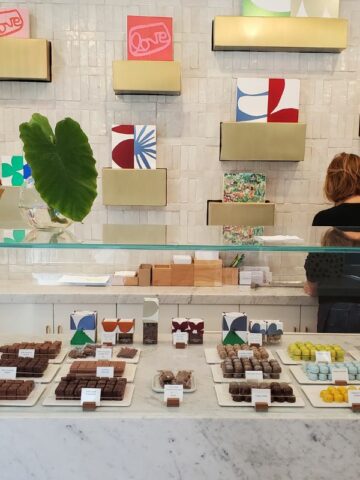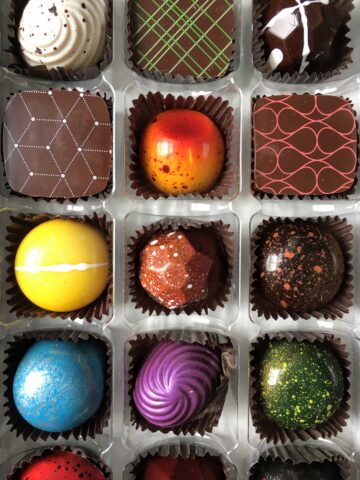Trends in Singapore tend to develop and spread rapidly, especially in the food industry. Some past examples include specialty coffee, black sugar, and salted egg everything. Each of these items has had their moment in the spotlight, and most have left a lasting legacy still open for business in one corner or another of the city-state. Coffee, in particular, is of interest to me here.
This is because the third-wave coffee movement that hit Singapore hard has paved the road, in some small way, for a similar product: craft chocolate. While the craft chocolate movement in Singapore is still at a very young and impressionable age, it's hard to deny that it's finally having a moment. Over the week I spent in the country, I noticed several up-and-coming chocolate shops in Singapore, both in person and online.
Singaporean chocolate culture has proved to be as hard to define as most every other aspect of the country; it's constantly in a state of flux. Interest in fine chocolate is still quite new there, so the bars in vogue are always changing. But one thing is for sure— Singaporeans are ready for something new, and companies are ready to make it.

Jump To
The Minimal History of Singaporean Cacao
Singapore is a tropical country in Southeast Asia. It’s now known as an international business hub, populated by locals and transplants from around the world. Similar to their northern neighbor of Malaysia, the native blend of the country is made up of Chinese, Indian, and Malay peoples. In fact, Singapore used to be part of Malaysia. This was after being a British colony, and up until it officially became independent in 1965.
After independence, Singapore didn’t immediately transform into a global banking hub, however. Over the course of a few decades, Singaporeans toiled and sacrificed to make the country into the financially successful and safe nation it is today. Many Singaporeans still remember the country as it was, with many times more farms, some of them quite close to the modern downtown area.

Just a few hours north of the country, on peninsular Malaysia, there are many cacao farms in the region of Malacca. During the nineteenth century, there were even experiments to try and grow cacao in the colony of Singapore, but the soil wasn't suitable for such a project so close to the ocean. The only place where you can see a cacao tree in Singapore these days is in the Singapore Botanic Garden, and even then it's only to look at.
Singapore's main history with cacao has been in the field of processing. The country used to import thousands of tons of cacao beans per year, processing them into cacao powder, butter, and liquor for export and domestic consumption. There are still some chocolate manufacturers based in Singapore, such as Aalst Chocolate and Nestle Singapore. However, most of these companies are now merely headquartered in Singapore and have their manufacturing stations in neighboring Malaysia or Indonesia.

Modern Chocolate Culture in Singapore
While there's been chocolate in Singapore for over 100 years, it's still a relatively new good for the general economy. While those in the Millennial generation may be quite familiar with it from childhood, to their parents and grandparents, chocolate was & often still is a rarity. "In those days, chocolate [was] something luxurious. Not many people had— especially the kids— had the chance to taste good chocolates... there were not many big brands around," says Ronald Ng.
Ronald is co-founder of Lemuel Chocolate, based in downtown Singapore, and he grew up in the Singapore of the 1970's. The only reason he ever had much chocolate was because his father worked for the Dutch chocolate company Van Houten, and later opened his own Singaporean chocolate factory. Three years after starting LeMuel, and they’re still the only physical bean to bar chocolate shop in Singapore. Even though demand for chocolate has grown over the years, it hasn’t exactly exploded.
Craft chocolate in particular has had a very slow burn in Singapore, unlike in nearby Thailand or Taiwan. It goes back to the fact of Singapore’s strong Chinese heritage, rapid development, and its hot weather. People are still reluctant to spend money on luxuries like chocolate, even today. Yet chocolate makers are finding hope in young Singaporeans, who aren’t keen on living in their grandparents’ world. Their country has changed, and so has their lifestyle. It’s all about balancing work and enjoyment.
For Singaporeans in their twenties and thirties, a lifestyle shift means savoring a fancy cup of coffee, or a bar of chocolate. Yet the hot weather and the strong Chinese influence upon the country’s culture is also important to note. One long-held Chinese belief is that chocolate is a "heaty" food, meaning that it can overheat the body and therefore you shouldn't consume much of it in hot weather. Unfortunately, Singaporean weather only registers hot and humid.

Craft Chocolate in Singapore
For those who are buying craft chocolate in Singapore, the main influencing factor is curiosity. People want to understand their food; they want to know where it comes from, how it got there, and why it tastes so damn good. Both Jay Chua and Charis Xie, two co-founders of Singapore's Fossa Chocolate, are of the “Millennial” generation, the youngest in the Singaporean workforce at the moment. In a lot of ways, they represent their current, curious customer base.
With single origin chocolates and inclusions like shrimp & bonito, sake kasu, salted egg cereal, they’re definitely offering grown-up chocolates. They're also incredibly transparent about where & how they source their ingredients, and the flavor inspiration behind each bar. This has kept them in business for over four years now. But Singapore's rank as the world’s most expensive city to live in means that the cost of renting production space alone starts at a few thousand dollars a month. While there are certainly other challenges, this has been one big issue for the young chocolate market.

Such luxury pricing also has very few models to look back on, though the country's young coffee culture has been the main precursor for that standard. Dima Minkov started Hello Chocolate with his wife, Nina, exactly 5 years ago this month, in April 2015. Mast Brothers Chocolate, from New York City, was one of their first brands as a company, because at the time they were one of the only "craft" chocolate brands with any name recognition in Singapore.
Similar to the brand recognition of Starbucks fifteen years ago, just five years ago Singaporeans were individually importing craft chocolate bars like the Mast Brothers, because they were first being exposed to it abroad. Dima and his wife were ready to meet and expand that local demand for fine chocolate, though it took years before there were many regular orders. Even now, there remains only one craft chocolate retail shop in Singapore.
There's also relatively little coverage for craft chocolate in Singapore's many media outlets, making people's interest in fine chocolate a numbers game. How many people can individual chocolate shops share their bars with, and how long will it be before those samples simply run out?

The Future of Chocolate in Singapore
Now five years into this chocolate revolution, the Singaporean palate has revealed itself quite a bit. Hello Chocolate is now selling more 100% and unroasted chocolate than ever, and offering more varied and unique bars as some people become more interested in nutrition facts than flavors. They have a mission, in educating consumers about the multifaceted benefits of craft. But especially in the face of the current health pandemic, it's unclear how much people will continue to invest into chocolate bars.
Undoubtedly, the presence of more places to buy fine chocolate has helped everyone know it's there. And as you can see from the growth of Fossa, Lemuel, and Hello Chocolate, people with the means to will buy better chocolate. But even before the pandemic, Fossa Chocolate was still selling only online, over four years after starting their operation. Despite all the parallels people draw between coffee and chocolate, the fact is that people still have more understanding of coffee.
With coffee, people think of a beverage and the beans it’s made from. Nothing more. But with chocolate, you can have hot cocoa or chocolate cake or a chocolate bar; the possibilities are endless. So customers’ expectations have become endless, too, and that won't halt during a global crisis. Add to that the high cost of materials & an insecure supply chain, and it’s a wonder that any craft chocolate maker stays in business.
But consumers just don’t realize that. They expect the same level of quality and creativity, but aren’t yet willing to withstand a ten-fold price increase, as has happened in coffee. So while coffee may have paved the way in terms of flavor, for Singaporeans, chocolate’s still got to prove itself. It needs to be proved above & beyond, and more worthy of their money than the alternative, no matter where or from whom they're buying.

















Tim
How are the Fossa tea chocolates? The dancong ones sound delicious.
Have you tried Claudio Corallo chocolate? It's grown near Nigeria and processed with more care than even your typical craft chocolate. They have a product flavored with cacao distillate that is amazing.
Max
They're delicious! And thankfully they're getting easier to find in the States. But I have tried Claudio Corallo, though it's been several years; they're not actually that easy to find here! That product sounds very cool, though.